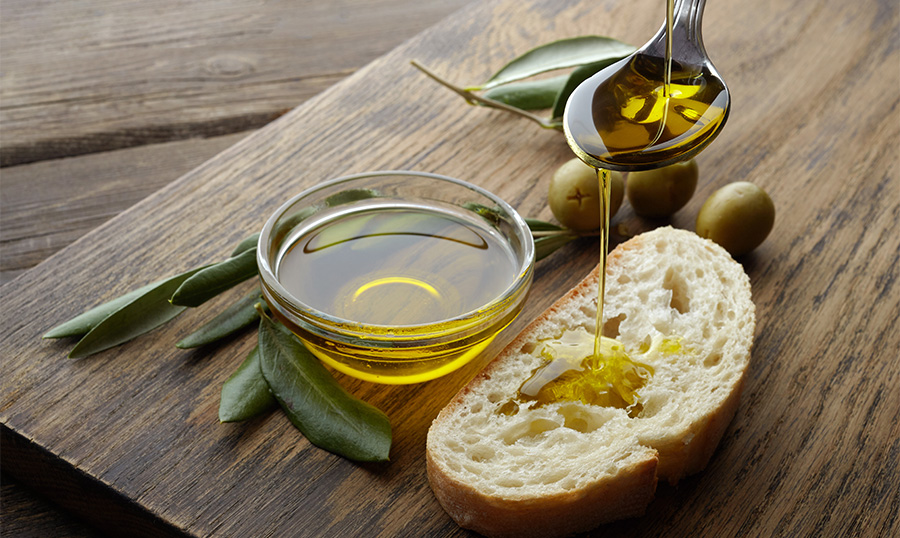The Smart Guide to Cooking Oils: What to Use, When

As a health-conscious eater who studies nutrition and loves to cook, I thought I knew what I needed to know about cooking oil.
I wasn’t at all surprised when a large study from Harvard and MIT recently found that a higher consumption of vegetable oils, and specifically soybean, canola, and olive oil, is associated with lower total, cancer, and cardiovascular mortality. Using these oils instead of butter, the researchers found, could lower mortality risk by 17%.
Heart-healthy extra virgin olive oil (EVOO) is my go-to choice, and I keep a large bottle within reach for making, well, just about everything. Sauteing? Check. Tossing with vegetables for roasting? Yep. To my family’s dismay, I sometimes even use it for baking cookies and muffins. (Admittedly, it imparts a weird flavor, but it’s better for us than butter, right?)
I keep a small bottle of fancy walnut oil in the cupboard for making special vinaigrettes. And I always have sesame oil around for flavoring certain Asian dishes.
Smoke point? Since I don’t fry food at home, I didn’t pay too much attention.
Expiration date? If oil is stored in a cabinet, it lasts for at least a few years … doesn’t it?
Turns out, a lot of my assumptions about oils, including how to use them, how to choose them, and how to store them were incomplete. Here’s what I’ve learned.
How to Choose the Right Cooking Oil for Health and Heat
Knowing how you plan to use oil is your best guide for which type to buy. Importantly, it will ensure you don’t damage the oil by overheating and also that you’re getting the most nutritional bang for your buck.
Probably the most important consideration is the oil’s smoke point or the temperature at which it begins to chemically degrade. Not only will the flavor and color of the oil change, but it will also quickly lose its nutritional value, producing inflammation-causing free radicals and other compounds that can harm health.
In short, smoke point absolutely matters when it comes to vegetable oil.
Here’s a quick guide:
1. For High-Heat Cooking
Use when stir-frying, sautéing, roasting, or grilling at high temperatures.
Choose: Avocado oil, canola oil, or untoasted sesame oil
These oils have high smoke points and stay stable at elevated temperatu
2. For Low-Heat Cooking or Finishing Dishes
Use for salad dressings, dipping, or drizzling over cooked vegetables and grains.
Choose: Extra virgin olive oil (EVOO), walnut oil, or toasted sesame oil
These oils add rich flavor and are packed with heart-healthy polyphenols—but break down at high heat.
3. For Nutritional Boosts in Raw Applications
Use in smoothies, protein shakes, or chilled dishes.
Choose: Flaxseed oil or hempseed oil
These oils are rich in omega-3 and omega-6 fatty acids but aren’t heat-stable—use cold only.
4. For Baking at 350°F or Higher
Use for muffins, cakes, or breads requiring neutral-tasting, heat-stable oils.
Choose: Canola oil or sunflower oil
They hold up well in the oven and won’t alter the flavor of baked goods.
(NOTE: Yes, there are seed oils in this list. See the section below called “Concerned About Seed Oils?” for why we included them in this review)
Which Type of Olive Oil Is Best for Cooking and Longevity?
This staple of the Mediterranean diet, olive oil is a fantastic replacement for saturated fats, like butter, in many food preparations.
As a monounsaturated fat, olive oil is generally credited with health benefits like reducing inflammation and oxidative stress, increasing HDL (“good”) cholesterol, and lowering blood pressure and blood sugar levels.
But its nutritional profile varies based on the kind of olive oil you use.
- Extra virgin olive oil (EVOO) contains the highest percentage of antioxidant polyphenols and vitamins. It’s cold-pressed, meaning the vegetal matter (in this case, the olive fruit) is mechanically pressed to extract the oil without the use of heat or chemical solvents.
- Cold-pressed oils of all kinds are considered a more nutritious and flavorful option because they retain more of the plant’s original compounds.
- Virgin olive oil (VOO) is also derived from cold-pressing the olives and still contains most of the olives’ polyphenolic and antioxidant compounds, but not as many as EVOO.
- “Light,” “pure,” or “classic” olive oils are made from a blend of oils, which have been filtered and refined. Refining involves high heat and often the use of chemicals to remove impurities, yields the lightest color and mildest flavor, and makes the oil last longer and better able to withstand higher temperatures. However, it also removes most of the oil’s nutrients.
When To Not Use Olive Oil
Olive oil may not be your best choice for cooking everything, says Grace Derocha, RD, a spokesperson for the Academy of Nutrition and Dietetics. This includes stir-fries, grilled or roasted foods, or baked goods where temps reach over 350 degrees.
Instead, save your fancy EVOO for low-heat preparations, drizzling atop finished foods, and making dressings or other sauces. For light-medium heat preparations, a virgin olive oil will hold up.
What to use instead:
Avocado oil. Another monounsaturated fatty acid that offers the same heart-health and antioxidant benefits as EVOO, but can withstand a higher temp has a more neutral flavor.
Canola oil, a healthy polyunsaturated fat with a neutral flavor and a medium-high to high smoke point, is another good and less expensive option.
Which Oil Is Best for What? A Quick-Reference Guide
Vegetable oil is a source of healthy fat … but it’s still fat
One tablespoon of olive oil has 119 calories. That’s not a lot, but a tablespoon is also not much.
If you use more than 1 T olive oil in your salad dressing, flaxseed oil in your afternoon smoothie, and slice avocado onto your morning grain bowl or dinner tacos, you may be adding more calories and fat to your daily diet than you intend.
And while all of these monounsaturated fats offer loads of nutritional benefits, too much of any fat isn’t good. “Fat impacts heart health,” says Derocha. “I like to tell people, when making oil substitutions and replacements, to think about quality over quantity.”
Here’s how to be oil smart: Use vegetable oil, even the most nutritious ones, wisely as one part of a healthy, balanced diet that keeps fat and calorie consumption in mind.
Coconut and Hemp Oil: Are They Healthy?
Coconut oil: As a saturated fat, coconut oil seems like it should fall firmly into the “avoid” or, at best, “use in moderation” camp. But this oil, which comes from the meat and milk of the coconut, is a bit of a contradiction. It contains large amounts of lauric acid, which some research indicates may increase HDL (“good” cholesterol) levels.
A few small studies found that coconut oil may suppress appetite and contribute to the loss of belly fat, which scientists say may be due to its medium chain triglycerides (MCT) or fats that the body absorbs readily and uses for energy. MCT has also been linked to benefits, including cognitive health, gastrointestinal health, increased endurance, and modest weight loss. But nutritionists warn that MCT derived from coconut oil is different from coconut oil you’d cook with and that any saturated fat should make up less than 10% of a healthy diet.
“Is coconut oil bad? No,” says Derocha. “Is it something to use in moderation? Definitely. It is nutrient-dense but also high in saturated fat. So be aware of how much you’re using and why you’re using it.”
Hemp seed oil: Made from the hemp plant, which is related to the cannabis plant but doesn’t contain traceable levels of psychoactive THC, hemp seed oil is derived from the same kind of cold-press extraction as olive oil, which retains many of its nutrients.
It’s particularly high in polyunsaturated fats, contains both omega-6 and omega-3 fatty acids, and may help lower blood pressure and inflammation and support heart health. But its low smoke point means it’s best used for finishing oil, salad dressings, or adding to smoothies or protein shakes. You wouldn’t want to cook with hemp oil.
Is Organic Cooking Oil Worth It for Your Health?
I’ll happily spend extra on organic produce and more for the assurance it provides about the way my food is grown and the standards by which it was produced. But when it comes to specialty oils, which can be pricey, I may pause before grabbing the organic bottle.
I’m going to rethink this. The risks of pesticide contamination are real, with research showing sometimes significant levels in olive and other edible vegetable oils. In a new study, 21 out of 50 samples of European extra virgin olive oil surpassed the EU’s standards for maximum residue level.
It makes sense. Huge amounts of plant matter are needed to produce vegetable oil. If those plants were treated with pesticides, it’s not surprising they’d show up in the oil. Ironically, more refined oils have lower contamination levels. The heat and layers of chemical processing destroy or filter out many pesticides.
A healthier choice: Go for the organic oil of every kind and particularly when using minimally processed cold-pressed oil, like EVOO, avocado, hemp, flaxseed, sesame, and walnut.
Concerned About Seed Oils?
A few years ago, seed oils were accused of fueling America’s obesity epidemic, causing systemic inflammation, and putting us at risk for multiple chronic diseases. At the heart of the concern was omega-6, an essential fatty acid, which, like omega-3, the body needs but does not produce.
Both are vital for physical functioning as well as heart and brain health. Omega-6 is specifically linked to lowering LDL cholesterol and improving insulin sensitivity. The American Heart Association supports incorporating it as part of a heart-healthy diet.
But there’s also been conflicting research suggesting omega-6 may both increase inflammation in the body and decrease it. This likely has to do with the ratio of omega-6 to omega-3 fatty acids consumed, nutritionists say. This ratio should be no more than a 2:1 ratio of omega-6 fatty acid to omega-3. “In our modern diet, the ratio is closer to 20:1, omega 6 to omega 3,” says Derocha.
Seed oils, including canola, corn, sunflower, safflower, and peanut oil have some of the highest levels of omega-6. They are also the oils most commonly used in processed and ultra-processed foods.
This is the bigger point, adds Derocha. It’s about the ratio of omega-6 fatty acid to omega-3.
Americans consume far more omega-6 fatty acids, in the form of processed foods, than omega-3s. Meanwhile, these foods also have high amounts of sugar, sodium, and refined grains. And the process of hydrogenating oil, so it remains shelf-stable, strips away the oil’s original nutrients.
“It’s this ratio of too much omega-6 to omega-3 that’s inflammatory,” Derocha says.
Consider the food source: Seeds and their oils provide healthy essential fatty acids our bodies can’t produce on their own. Enjoy the seeds themselves and unprocessed versions of their oils. But consuming too much processed food that contains seed oils is never going to be the healthy choice.
How to Store Your Cooking Oils Properly
Cooking oils are nutrition powerhouses—but only if you store them right. Exposure to heat, light, and air can break down oils, turning heart-healthy fats into flavorless (or worse, harmful) compounds. Here’s how to protect your investment—and your health—by storing your oils the smart way.
1. Keep Oils Away from Heat and Light
If you keep your favorite cooking oil by your stovetop for easy reach, you’re likely causing its degradation. Oil needs to be protected from heat and light to last. That’s why olive oil, at least, often comes in dark green bottles. All vegetable oils will last longer and retain more of their flavor and nutrients when stored in cool, dark places.
2. Refrigerate Delicate Oils
Specialty oils like flaxseed or walnut oil are especially prone to spoiling. Extend their shelf life and preserve nutrients by keeping them in the fridge.
3. Always Seal the Cap Tightly
Importantly, make sure to firmly close the cap after using, says Derocha. This helps keep the oil from oxidizing, protecting flavor and shelf life.
4. Check the Expiration Date
Speaking of shelf life, check the expiration date on oil when you purchase it (consider circling it so it’s easier to notice when you use it). Oils naturally change over time, with some lasting just 6 months while others may last 2 years.
5. Learn the Signs of Spoilage
You can tell if an oil has started to go bad by the smell, which is sometimes described like Play-doh or crayons, says Derocha. “When in doubt, throw it out,” she advises.
6. Buy Smaller Bottles for Infrequent Use
If you don’t use a particular oil often, consider buying a smaller bottle, she says. It may cost more, but you also won’t need to throw away rancid oil three years from now.
Do Vegetable Oils Contain Microplastics? What the Research Says
A disturbing study published last year found microplastic particles in every sample of edible oil tested, regardless of whether it was packaged in a plastic or glass container. The study, from researchers in Italy and Spain, analyzed EVOO, other olive oil, sunflower oil, and mixed seed oils from both countries.
The researchers couldn’t determine whether plastic came from the packaging or from the oil itself, absorbed somewhere during the production process. It may have come from the original plant matter.
“This is definitely an area of emerging concern,” says Derocha. As a nutritionist, she admits feeling dismayed by this study, and growing evidence of how plastics have infiltrated our food systems.
To cope, she tries to focus on what she can control, like supporting brands that have transparency about their processes, and choosing organic and more minimally processed oils whenever possible.
The takeaway: Try to eat as clean as you can. No studies have compared organic and conventional oil in regards to plastics, but choosing brands and products that make a conscious effort to keep their products clear of contamination of all kinds seems like the safest bet.
The information provided in this article is for educational and informational purposes only and is not intended as health or medical advice. Do not use this information to diagnose or treat any health condition. Always consult a qualified healthcare provider regarding any questions you may have about a medical condition or health objectives. Read our disclaimers.
Your body’s response to an illness, injury or something that doesn’t belong in your body (like germs or toxic chemicals).
Learn MoreLiving a long life; influenced by genetics, environment, and lifestyle.
Learn More



